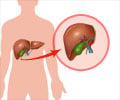Fat production by the liver runs on a 24-hour cycle, the circadian rhythm, and is similar to the sleep-wake cycle.

When those molecules do not do their jobs, the liver dramatically fills with fat.
Mitchell Lazar, director of the Institute for Diabetes, Obesity, and Metabolism, and his colleagues found a team of molecules that, in normal mice, migrates to the genome of liver cells during the daytime.
One of the team members, a protein called Rev-erb, delivers the molecular workers to thousands of specific locations in the liver genome, many of which are near genes involved in the production of fat.
Another team member, called histone deacetylase 3 (HDAC3), does construction work on the protein scaffold (the epigenome) surrounding the genome to dampen the activity of the fat-related genes.
"This work shows that the epigenome, which is critical for regulating how genes are expressed, undergoes reversible remodeling every day," said Lazar.
Advertisement
During the night, the day shift molecules depart the liver genome, and fat production increases due to other regulatory molecules.
Advertisement
However, if either Rev-erb or HDAC3 is prevented from doing its job, the cycles do not occur, and the liver fills with fat.
By sequencing the DNA associated with HDAC-3 in the liver the Penn team found HDAC in 100 places in the liver genome at 5am, but 12 hours later at 5pm, HDAC was present in 15,000 places in the liver genome, indicating that it had been brought to the liver during the day.
They also found that Rev-erb follows the same daily pattern, because it is the protein that gives HDAC-3 a ride to work.
The findings are reported in this week's issue of Science.
Source-ANI














